10) Ganymede Elegy
So at the end of the previous episode, for reasons never adequately explained, Ed wound up joining the crew of the Bebop full-time. Other than the opening credits, there’s nothing to suggest that Ed was more likely to become a recurring cast member than Rocco was (or even V.T.) But here she is, and here she’ll stay. And I’m sure she’ll find a role to play on the crew. Like hacking computers! Or… say… torturing prisoners?
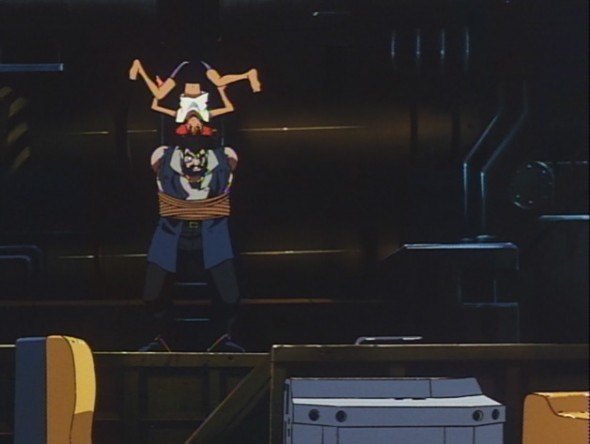

Well show me in the Geneva Convention where it says you CAN'T have a feral child bite prisoners on the face? Oh, right on the first page then? Oh. Well then. I see.
This one opens with the crew cashing in the bounty on Baker Panchorero, who they apparently captured sometime in the break between episodes. The interesting thing about Baker – the only thing about him really, as he’s on screen for all of a minute – is how much his character art is meant as an echo of Jet Black’s. And appropriately enough, the main plot of this episode is about how Jet too is “tied up” by his past mistakes and regrets.
Having come to Ganymede, Jet decides to pay a visit to his ex, Alisa, who runs a failing bar called (appropriately enough) Le Fin. Each episode has a fairly elaborate musical number that plays over a montage establishing the geography and culture of whatever new planet or asteroid they’re on, and this is no exception. But I’d kind of like you to stop and listen to it, because the music is truly exceptional. (Skip to about 5:30 into the video).
http://www.youtube.com/watch?v=50ArHQvlhHs
When I first heard that song, I assumed it was some brilliant jazz standard that I’d never heard before. It’s so, so true to the idiom. But it’s a Yoko Kanno original: in fact, this is the melody that was introduced as the music-box music in “A Waltz For Venus.” Genius. (While we’re on the topic of music, there’s no connection between this one and Episode 4 that I could detect. Phew.)

Ah, the drinky bird. If there's a better symbol for the mechanistic passing of time and the merciless onslaught of entropy, I don't want to know about it.
Anyway, Jet finds his ex’s bar, and meets her hostile, twitchy boyfriend, Rhint (who, to absolutely nobody’s surprise, will later turn out to be the bounty of the week). Rhint heads out for a smoke, though, and Jet and Alisa have a conversation that would probably seem pleasant if it wasn’t for the weird, jumpy editing, which makes it seem like someone’s going to throw a punch any second. It turns out that Jet’s after answers: Alisa left him without explanation back when he was a cop on Ganymede, and he’s always wanted to know why. And at first, she won’t tell him. Instead, she just tells him to move on and get over it. “That’s a story from long ago,” she tells him. “I have no use for time that stands still.” Which is a great line, both because it ties together the episode’s symbolic vocabulary (Jet’s stopped watch contrasted with the sounds of the clocks and the drinky-bird in Alisa’s restaurant), and because it’s kind of an amazing rebuke to the show’s entire ethos. But later, after an intense spaceship/boat chase, she explains: Jet was always taking care of her, to the point where she didn’t get to live her own life. “All I did was wait for you to come home.”
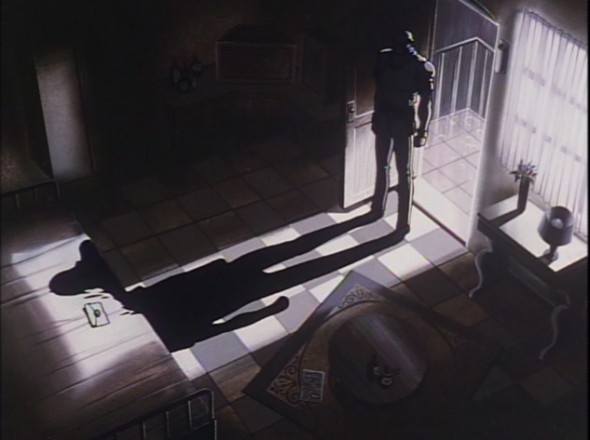
Jet gets a Dear John letter. You can tell it's in the past, 'cause it's all sepia toned.
The ending of the episode is, uh, open to interpretation. You could argue that Jet learns his lesson and decides to move on, and helps Rhint get off on a self defense charge as a parting gift. This seems to be the version that the voice actors subscribe to. You could also argue that Jet has learned nothing. Because what he actually tells Rhint as he collars him is, in as many words, “Be a man and shoulder this murder rap so that Alisa doesn’t have to suffer.” That is: “Look, she doesn’t want me infantilizing her any more, so you’re going to have to do it.” This is the version I prefer, and it also seems to be the version that the animators were thinking of. Alisa ends the episode by saying that she’ll go back to waiting in her restaurant, only now instead of waiting for Jet to come home from being a cop, she’ll be waiting for Rhint to come home from jail. She sounds moderately happy. She doesn’t look happy, though.


The animators haven't gotten tired of the "Dog in zero-gee environment" gags, and I hope they never will.
Well, that was certainly a mountain of text! What else is there to say about these episodes? Well, sessions 1-5 taken as a whole, seemed to be about creating a shifting pattern of comedy and drama. This batch is a lot more consistently dramatic. In 1-5, only one episode (#5) really dug into the past of one of the main characters. That’s sort of true here too, with #10 exposing a lot more than we’d known thus far about Jet. But the division between #10 and the others isn’t all that sharp. Basically these are all about depicting an interesting one-shot character (the harmonica player, V.T., Rocco, Ed – who counts as a side character at that point – and Alisa) and running them through some variation on a single theme: that the only way to get through past trauma is by reliving the trauma in the present.
• This is made clearest in Sympathy for the Devil. The harmonica player has a traumatic event sometime in his past. As a result, he stops aging and turns evil, essentially stepping outside of time and society. At the end of the episode, Spike restores all of this to him: his place in society, his trauma, and his time. He dies, of course, but it’s presented as a good thing.
• In Heavy Metal Queen, VT has a traumatic episode in her past when her husband dies. As a result, she leaves the society of bounty hunters (although she joins a warm and friendly community of space truckers). At the end… well, you don’t get the feeling that she’s ever going to stop being a space trucker, but she’s reopened diplomatic relations with bounty hunter society, and you feel like her personal trauma is somewhat eased. And this requires a double whammy of traumatic events. First, there’s all the incident that makes up the body of the show: she puts her own life on the line several times, and a dude, a truck, and an abandoned mining satellite are all blown up during the course of her catharsis. Second, Spike guesses her name. She isn’t really bothered by this, but mark me, it’s traumatic. Learning someone’s true name, in stories, is a way to gain power over them. And it means that Spike beats her: penetrates her psychological armor, learns her true nature, and drags her out into the open.
• Waltz for Venus doesn’t actually fit into this pattern very well, but you can still kind of make it work. Stella had a traumatic encounter with a plant in her youth, and lost her ability to see. This removes her from society – and note that from a disabilities studies perspective, the way Cowboy Bebop treats this girl is just awful. At the end of the episode, they’re able to use another plant to restore her sight (and presumably her place in society), but this requires Rocco to die, sort of displacing the trauma.
• In Jamming With Edward, there’s an ancient (thus, outside of time) and isolated (thus, outside of society) communications satellite. The traumatic gate incident caused its isolation, although I suppose you could argue that in this case loneliness itself that is the real trauma. At the end of the show, the crew of the Bebop blast their way past the satellite’s defenses and more or less abducts the AI, thus returning it to time and society. This invasion could be seen as the traumatic act, or if you like, the Nazca lines that the satellite and Radical Edward blast into the surface of the Earth could be seen as a recapitulation of the other, more dramatic, blasting of the surface caused by the Gate Incident.
• Ganymede Elegy is an interesting one. Watching this episode, you really think that Rhint or Alisa or both are going to end up dead. This is partially because the structure and aesthetics of the episode are almost identical to the first episode, Asteroid Blues, which you might remember ended about as traumatically as anyone could hope for. (Young lovers on the run from the mob, the cops, and Spike, big chase scene where one of them pulls a handgun, fight scenes in monochrome shakey-cam… and the similarities don’t stop there.) But it’s also because we assume that Jet and Alisa’s past trauma is going to need to be resolved with a gunshot just because that seems to be the name of the game here in noirland. So when you realize that Rhint’s just going to jail, it’s really kind of a relief. Even though Jet ends up dragging his answers out of Alisa, you feel like the trauma has been avoided. And his parting words to her, “You won’t be waiting long. Time is still flowing along,” suggests that just getting along with your life might be possible in some limited situations. The music may play a role here too. The episode has kind of set up that jazz song — called “The Singing Sea” on the soundtrack — as Jet’s theme. Alisa has a theme too: a latin-inflected guitar number in 3/4 time, which has a very clear phrase structure and leads to a very standard cadence. And even though he “won,” it’s her music that shows up at the end of the episode. This is especially striking because The Singing Sea has already been used to end one episode (Waltz for Venus), and contains the honky-tonk piano tag that’s been playing at the end of almost every episode. Abandoning this for new music could symbolize the opening of a new chapter in the characters’ lives. You could even argue that jazz, with its constant melodic variations over relatively static chord changes, is less goal-oriented, less temporal, than the folksy guitar texture that replaces it. You’d be taking some wild swings, but you could make the argument.
Although I’m no longer so sure what the pattern of dark vs. light episodes is working out to be, some of my broader points from last time around do still hold. You still get these inexplicable moments of kinetic jouissance, although a lot of them feel more lyrical than action packed this time around. (See especially the chase scene from Ganymede Elegy). The withholding of information is still a big tactic. In Sympathy for the Devil, they sort of explain why the harmonica kid never gets any older… but they never explain why he’s bulletproof. And even the explanation they give for the aging thing is lampshaded as empty technobabble.
And formalism is still a huge part of how the series works. This time around, I’ve been getting a real kick out of how it works on the smaller scale. Check out this series of shots from Sympathy For the Devil:
Standing over the corpse of his former bounty, Spike looks at the triangular pink ring that the dying man gave him. It suddenly starts to sparkle…
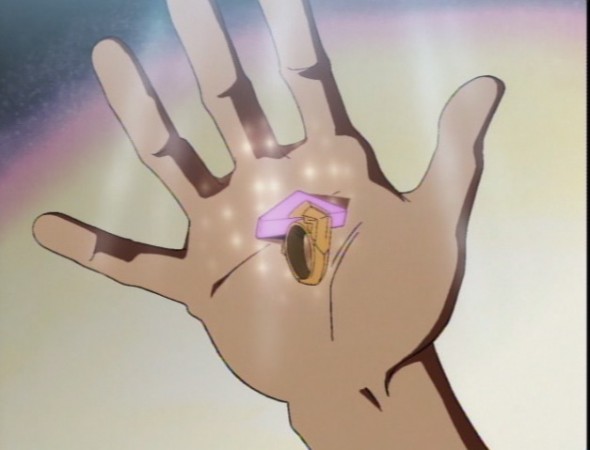
…which in the next shot is revealed to be caused by the lights of the police cruisers which surround Spike’s triangular red spaceship (located more or less in the same part of the frame where the ring was)…
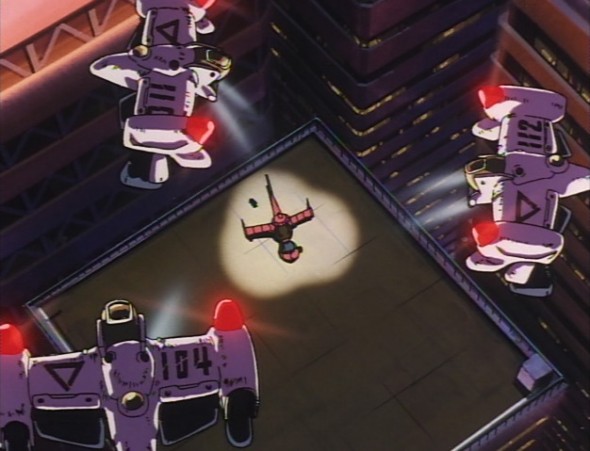
… and a couple of shots later, we cut back to the ring, now with Jet’s scanning device taking the place of the police cruisers. Note that, even though there are five lenses (or whatever) on the device, they are broken up into three groups, to match the three police cruisers.
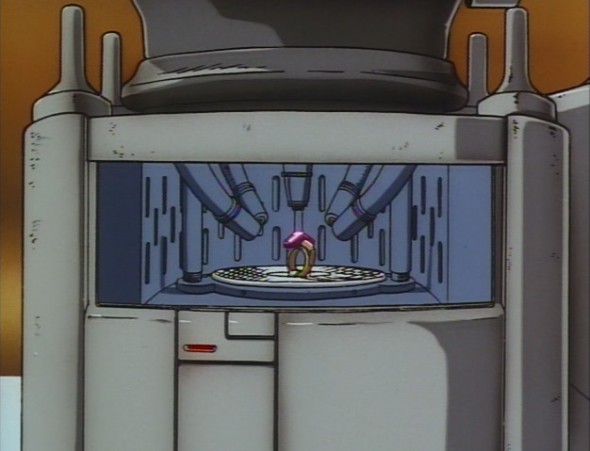
Neat, huh? There’s another nice bit from the same episode where a warm red-orange glow is used in shots of the harmonica player performing very early in the episode
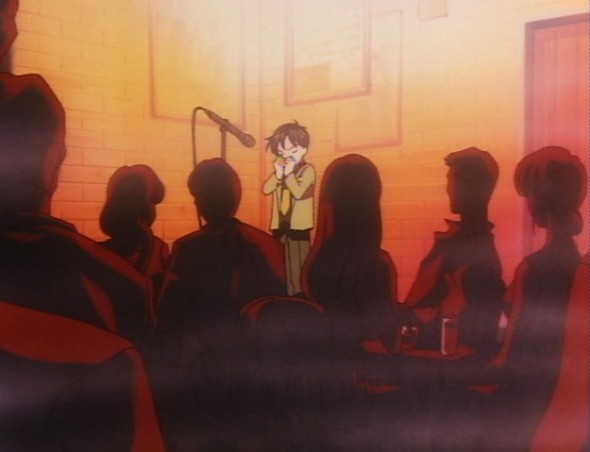
… and about halfway through the episode…
… in order to set up and foreshadow a similar glow in the climactic gas station battle…

…which does not have diagetic music but does have the episode’s most prominent and exciting piece of underscoring. Very cool stuff.
I have a theory about why they use these self-conscious, so-clever-it-hurts constructions. It has to do with whether Cowboy Bebop can really be thought of as a parody of less self-conscious shows, or whether something else is going on. But it’ll have to wait till next time – this is pushing 5,000 words as it is. Gentles, for your patience thanks. Oh, and a quick question for the comments: what are some specific movie references you’ve noticed in the series? There seem to be an awful lot, and I’m sure I haven’t noticed them all. Feel free to list ones from future episodes if you like, but to avoid spoilers please just list the name of the episode and the name of the movie it references, rather than going into detail.

WOW, the writing in this gets sloppy near the end. Sorry about that. Okay, no more podcasting for me on days that I also have posts due.
This series has always reminded me of the film “The Long Goodbye” starring Elliot Gould (who is a dead ringer for spike). A future episode even deals with a criminal faking his death. Other than that great review so far
On the “trailer” for this post on the Main Page (the big image on the front page which changes every few seconds), it says in the tagline “Belinkie continues his trek through Cowboy Bebop.”
Is the editor in chief trying to make mischief?
Oops. Fixed now. No mischief to see here. Move along!
This series continues to be outstanding. Good job, Stokes!